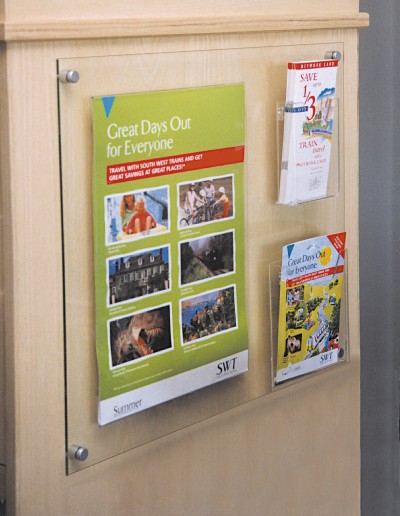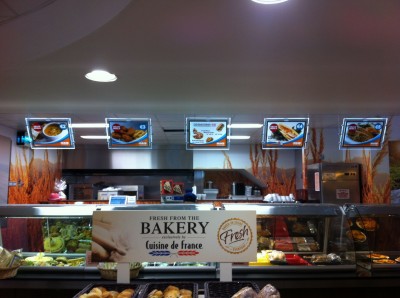Materials and finishes
As mentioned, the quality of the materials and finishes used for today’s sign standoff systems and suspended cable or rod systems varies significantly, so it is important to select those that will enhance a sign’s design. They range from less expensive aluminum fittings to more elegant solid brass fittings with a satin chrome or high-gloss polished finish.
The higher-quality brass fittings with smooth threads may even come with a lifetime guarantee. Indeed, it is not unusual, after 10 years or so, to see brass standoffs outlast the signs to which they are attached.

Acrylic pockets allow graphics and other printed materials to be dropped into place as desired, without the need for any tools.
Less expensive aluminum standoffs and cables can provide a similar appearance to their brass counterparts, but will have a much shorter useful life and are not suitable for sign installations in moist environments, as dampness can negatively affect their threads. Even something as simple as storing a damp umbrella in an office reception area could cause a problem for nearby signs. If aluminum fittings have a manufacturer’s guarantee at all, it is typically only for one year.
In a suspended rod system, meanwhile, brushed stainless steel is preferable, since galvanized steel rods will tarnish and aluminum is not nearly as strong. The material used can thus make a big difference to the sign installation’s appearance even after just a short period.
Dimensional designs
Given how visual impact is key in creating an outstanding sign that sets the client apart from its competition, in addition to using different textures and colours of acrylic, vinyl lettering and/or full-colour digitally printed graphics, it is also worthwhile to consider how fixtures can be used to add further depth to signs.
Dimensional designs for logos and sign panels may involve joining two or three fixtures of different depths, for example, by adding special fittings that create gaps of around 6 mm (0.24 in.) between the fixtures.
It has become fashionable for signmakers to create ‘sandblasted’ effects with lettering reversed out or clear signs with dark lettering. In this case, the use of double-depth fixtures allows a solid, dark-coloured panel to be put behind the clear panel, which will soak up any unwanted shadows that would otherwise result from angling spotlights toward the display.
Cable and rod systems allow even more freedom of design. Some arrangements see several vertical graphic panels of different sizes dropped in front of each other, creating a ‘stepped’ effect.
In other cases, it may be preferable to fix several signs closely together, either as a collage or in a long line, and to reduce the number of fixtures used. In such instances, the key is to select a special fixture that can support multiple edges. It will be much more compact—and less expensive—to use one wall fixture and a multiple panel joiner, rather than several separate fixtures.
Another factor is lighting, which is becoming easier to integrate into even the most basic signage, thanks to the compact size and minimal heat generation of light-emitting diodes (LEDs). To add a touch of sparkle, they can be added behind sign panels mounted with standoffs or even clipped to cable and rod systems. An illuminated sign can be achieved at any display height, without the need for complicated wiring.






